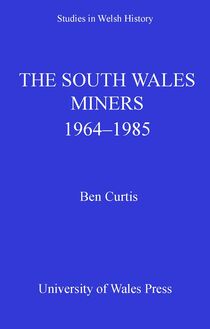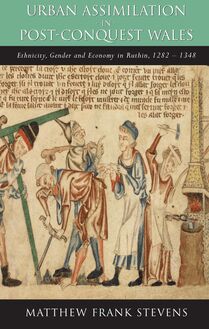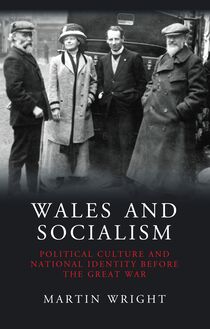-
 Univers
Univers
-
 Ebooks
Ebooks
-
 Livres audio
Livres audio
-
 Presse
Presse
-
 Podcasts
Podcasts
-
 BD
BD
-
 Documents
Documents
-
- Cours
- Révisions
- Ressources pédagogiques
- Sciences de l’éducation
- Manuels scolaires
- Langues
- Travaux de classe
- Annales de BEP
- Etudes supérieures
- Maternelle et primaire
- Fiches de lecture
- Orientation scolaire
- Méthodologie
- Corrigés de devoir
- Annales d’examens et concours
- Annales du bac
- Annales du brevet
- Rapports de stage
La lecture à portée de main
Vous pourrez modifier la taille du texte de cet ouvrage
Découvre YouScribe en t'inscrivant gratuitement
Je m'inscrisThe Gentry of North Wales in the Later Middle Ages , livre ebook
Découvre YouScribe en t'inscrivant gratuitement
Je m'inscrisEn savoir plus
Vous pourrez modifier la taille du texte de cet ouvrage
En savoir plus

Description
This is a study of the landed gentry of north Wales from the Edwardian conquest in the thirteenth century to the incorporation of Wales in the Tudor state in the sixteenth. The limitation of the discussion to north Wales is deliberate; there has often been a tendency to treat Wales as a single region, but it is important to stress that, like any other country, it is itself made up of regions and that a uniformity based on generalisation cannot be imposed. This book describes the development of the gentry in one part of Wales from an earlier social structure and an earlier pattern of land tenure, and how the gentry came to rule their localities. There have been a number of studies of the medieval English gentry, usually based on individual counties, but the emphasis in a Welsh study is not necessarily the same as that in one relating to England. The rich corpus of medieval poetry addressed to the leaders of native society and the wealth of genealogical material and its potential are two examples of this difference in emphasis.
Preface
List of Abbreviations
1. Who Were the Gentry?
2. Leaders of the Community
3. Office and Service
4. The Political Nation
5. The Wealth of the Gentry
6. Marriage and Family
7. The Way They Lived Then
8. Cultural Patrons
9 New Horizons
Bibliography
Index
Sujets
Informations
| Publié par | University of Wales Press |
| Date de parution | 12 octobre 2017 |
| Nombre de lectures | 0 |
| EAN13 | 9781786831378 |
| Langue | English |
Informations légales : prix de location à la page 0,1042€. Cette information est donnée uniquement à titre indicatif conformément à la législation en vigueur.
Extrait
STUDIES IN WELSH HISTORY
Editors
RALPH A. GRIFFITHS CHRIS WILLIAMS ERYN M. WHITE
36
THE GENTRY OF NORTH WALES IN THE LATER MIDDLE AGES
THE GENTRY OF NORTH WALES IN THE LATER MIDDLE AGES
by A. D. CARR
© A. D. Carr, 2017
All rights reserved. No part of this book may be reproduced in any material form (including photocopying or storing it in any medium by electronic means and whether or not transiently or incidentally to some other use of this publication) without the written permission of the copyright owner. Applications for the copyright owner’s written permission to reproduce any part of this publication should be addressed to the University of Wales Press, 10 Columbus Walk, Brigantine Place, Cardiff CF10 4UP.
www.uwp.co.uk
British Library CIP Data
A catalogue record for this book is available from the British Library
ISBN 978-1-78683-135-4
eISBN 978-1-78683137-8
The University of Wales Press acknowledges the financial support of the Welsh Books Council.
The right of A. D. Carr to be identified as author of this work has been asserted in accordance with sections 77 and 79 of the Copyright, Designs and Patents Act 1988.
The publisher has no responsibility for the persistence or accuracy of URLs for any external or third-party internet websites referred to in this book, and does not guarantee that any content on such websites is, or will remain, accurate or appropriate.
Cover image: Detail of the heraldic pedigree roll of Sir Thomas Hanmer, by William Llŷn (d. 1580). NLW, Bettisfield Doc. 137, by permission of Llyfrgell Genedlaethol Cymru/National Library of Wales.
SERIES EDITORS’ FOREWORD
Since the foundation of the series in 1977, the study of Wales’s history has attracted growing attention among historians internationally and continues to enjoy a vigorous popularity. Not only are approaches, both traditional and new, to the study of history in general being successfully applied in a Welsh context, but Wales’s historical experience is increasingly appreciated by writers on British, European and world history. These advances have been especially marked in the university institutions in Wales itself.
In order to make more widely available the conclusions of original research, much of it of limited accessibility in postgraduate dissertations and theses, in 1977 the History and Law Committee of the Board of Celtic Studies inaugurated this series of monographs, Studies in Welsh History . It was anticipated that many of the volumes would originate in research conducted in the University of Wales or under the auspices of the Board of Celtic Studies, and so it proved. Although the Board of Celtic Studies no longer exists, the University of Wales Press continues to sponsor the series. It seeks to publish significant contributions made by researchers in Wales and elsewhere. Its primary aim is to serve historical scholarship and to encourage the study of Welsh history.
CONTENTS
SERIES EDITORS’ FOREWORD
PREFACE
LIST OF ABBREVIATIONS
GLOSSARY
1 Who Were the Gentry?
2 Office and Service
3 The Wealth of the Gentry
4 The Political Nation
5 Marriage and Family
Appendix: Marriage Alliances
6 The Way They Lived Then
7 Cultural Patronage
8 New Horizons
BIBLIOGRAPHY
I Glenda gyda diolch
PREFACE
This book has grown out of a course I taught at Bangor University on the making of the Welsh gentry which examined the emergence and growth of the Welsh political nation before the Tudor union legislation. It discusses the transition from a social structure based on kindred and on a pattern of land tenure based on lineage groups to an emphasis on land as the basis of individual wealth and influence. At the same time the leaders of this class who were the leaders of the native Welsh community came to dominate native society and this dominance persisted until at least the nineteenth century. While preparing this course I realised that there was no general book on the medieval Welsh gentry and this book is an attempt to fill that gap. The concentration on north Wales, both east and west of the Conwy, is deliberate. In the British context Wales is generally perceived as a single region but in reality it is more than that; it is as much made up of regions as is England or France, albeit not on the same scale. There is a world of difference between Anglesey and Glamorgan or between Flintshire and Ceredigion.
In preparing this book I have benefited from the work of many others, as the bibliography and the references show. I am particularly indebted to my friends and former colleagues the late Tomos Roberts and Einion Thomas, successive archivists at what is now the University of Bangor, and to the late Alyn Giles Jones, who laid the foundations of the professional and efficient organisation which the archives now are. I also owe much to my former colleagues Professor J. Gwynn Williams, Nia Powell and William Griffith, and I am particularly grateful to Alison Davies of Mapping Company Ltd who prepared the maps and to Dr Llion Wigley of the University of Wales Press for his help and advice. Several cohorts of students followed this course and I appreciate their contributions to our discussions. Above all I am grateful to my wife Glenda for her constant interest and support, especially during those dark nights of the soul when I wondered if it was worth carrying on with a project which had already taken so long. The dedication to her is a pleasure.
A. D. CARR
ABBREVIATIONS
Arch.Camb.
Archaeologia Cambrensis
BBCS
Bulletin of the Board of Celtic Studies
BPR
Register of the Black Prince
BUASC
Bangor University Archives and Special Collections
CAC
Calendar of Ancient Correspondence concerning Wales
CAP
Calendar of Ancient Petitions relating to Wales
C.Chart.R.
Calendar of the Charter Rolls
CCR
Calendar of the Close Rolls
Cal.Chanc.R.Var.
Calendar of Chancery Rolls Various
Cal.Inq.Misc.
Calendar of Inquisitions Miscellaneous
CalIPM
Calendar of Inquisitions Post Mortem
CPR
Calendar of the Patent Rolls
CRR
Calendar of the Chester Recognisance Rolls
DRO
Denbighshire Record Office, Ruthin
DWB
Dictionary of Welsh Biography
Econ.Hist.R.
Economic History Review
EHR
English Historical Review
Fasti
Fasti Ecclesiae Anglicanae 1300–1541: The Welsh Dioceses
FMA 1301–28
Flintshire Ministers’ Accounts 1301–1328
FMA 1328–53
Flintshire Ministers’ Accounts 1328–1353
FRO
Flintshire Record Office, Hawarden Gwydir History History of the Gwydir Family
JFHS
Journal of the Flintshire Historical Society
JMHRS
Journal of the Merioneth Historical and Record Society
LlC
Llên Cymru
MLSR
The Merioneth Lay Subsidy Roll 1292–3
Mont.Coll.
Montgomeryshire Collections
NLW
National Library of Wales, Aberystwyth
PACF
Pedigrees of Anglesey and Caernarvonshire Families
Rec.Caern.
Registrum Vulgariter Nuncupatum The Record of Caernarvon
Reg.Peckham
Registrum Epistolarum Fratris Johannis Peckham Archiepiscopi Cantuarensis
SC
Studia Celtica
SD
Survey of the Honour of Denbigh
TAAS
Transactions of the Anglesey Antiquarian Society and Field Club
TCHS
Transactions of the Caernarfonshire Historical Society
TDHS
Transactions of the Denbighshire Historical Society
THSC
Transactions of the Honourable Society of Cymmrodorion
TNA
The National Archives, Kew WG Welsh Genealogies
WHR
Welsh History Review
YB
Ysgrifau Beirniadol
GLOSSARY
Amobr
The fine due for the loss of a woman’s virginity paid to the lord when she married or on other relevant occasions.
Awdl
Poem employing one or more of the traditional strict metres.
Cantref
The basic Welsh territorial administrative unit.
Commote
A subdivision of the cantref corresponding approximately to the English hundred.
Carucate
Originally the amount of land which could be worked by one plough team. It came to mean an area of land ranging from 60 to 120 acres.
Cywydd
Strict-metre poem composed of rhyming couplets.
Eisteddfod
Now a competitive festival for poets and musicians but formerly a public examination of their skills where degrees would be awarded.
Englyn (pl. englynion )
Epigrammatic stanza in strict metres.
Farm
Farming was a practice used extensively by medieval rulers; a lump sum was paid for the lease of an office or some other piece of royal or seigneurial property and the income was then retained by the lessee. The ruler thus had an assured income without the trouble of collection.
Fine
A payment made, usually in court, for licence to do something not otherwise allowed, for example by a bondman for permission to take holy orders or to make a will or in Wales for a tenant to acquire land to be held by English tenure.
Gafael
Like the gwely , a holding of land held by a kindred group. In some parts of north Wales it was the predominant unit of tenure, while in others it was a subdivision of the gwely .
Gobrestyn
An investiture fee paid in addition to the relief to take up an inheritance when the heir was not a direct descendant of the deceased tenant.
Gwely
A kindred group descended from a common ancestor and sharing proprietary rights in land, also the actual land held by the group.
Gwlad
One of the kingdoms into which medieval Wales was divided; the basic unit of Welsh political authority and kingship.
Inquisition post mortem
An enquiry carried out by the escheator on the death of a tenant-in-chief to ascertain what lands he held, their value and the nature of the tenure.
Maerdref
The unfree township in each commote attached to the royal court there for its maintenance.
Pannage
A payment due from tenants to enable their pigs to forage in the lord’s woods.
Pennaeth (Welsh barony)
The tenure by which Welsh aristocrats, descendants of native dynasties, held of the prince or later the Crown.
Plaid
The retinue of an uchelwr , usually made up of kinsmen, tenants and former soldiers.
Quo Warranto
A writ o

Ebooks
Exodus from Cardiganshire
Kathryn Cooper


Ebooks
Wales and the Crusades
Kathryn Hurlock


Ebooks
The South Wales Miners
Ben Curtis


Ebooks
The Women's Suffrage Movement in Wales, 1866-1928
Ryland Wallace

Ebooks
Sciences humaines et sociales
The Women's Suffrage Movement in Wales, 1866-1928
Ryland Wallace
167 pages
English

Ebooks
The Women's Suffrage Movement in Wales, 1866-1928
Ryland Wallace

Ebooks
Sciences humaines et sociales
The Women's Suffrage Movement in Wales, 1866-1928
Ryland Wallace
352 pages
English

Ebooks
The Gentry of North Wales in the Later Middle Ages
Antony Carr

Ebooks
Histoire
The Gentry of North Wales in the Later Middle Ages
Antony Carr
152 pages
English

Ebooks
The Communist Party of Great Britain and the National Question in Wales, 1920-1991
Douglas Jones

Ebooks
Politique
The Communist Party of Great Britain and the National Question in Wales, 1920-1991
Douglas Jones
167 pages
English

Ebooks
The Opposition to the Great War in Wales 1914-1918
Aled Eirug

Ebooks
Histoire
The Opposition to the Great War in Wales 1914-1918
Aled Eirug
155 pages
English

Ebooks
The Opposition to the Great War in Wales 1914-1918
Aled Eirug

Ebooks
Histoire
The Opposition to the Great War in Wales 1914-1918
Aled Eirug
282 pages
English

Ebooks
Intelligent Town
Louise Miskell


Ebooks
Urban Assimilation in Post-Conquest Wales
Matthew Stevens

Ebooks
Histoire
Urban Assimilation in Post-Conquest Wales
Matthew Stevens
125 pages
English

Ebooks
War and Society in Medieval Wales 633-1283
Sean Davies


Ebooks
Wales and Socialism
Martin Wright


Ebooks
Wales and the Crusades
Kathryn Hurlock


Ebooks
Urban Assimilation in Post-Conquest Wales
Matthew Stevens

Ebooks
Histoire
Urban Assimilation in Post-Conquest Wales
Matthew Stevens
298 pages
English
-
 Univers
Univers
-
 Ebooks
Ebooks
-
 Livres audio
Livres audio
-
 Presse
Presse
-
 Podcasts
Podcasts
-
 BD
BD
-
 Documents
Documents
-
Jeunesse
-
Littérature
-
Ressources professionnelles
-
Santé et bien-être
-
Savoirs
-
Education
-
Loisirs et hobbies
-
Art, musique et cinéma
-
Actualité et débat de société
-
Jeunesse
-
Littérature
-
Ressources professionnelles
-
Santé et bien-être
-
Savoirs
-
Education
-
Loisirs et hobbies
-
Art, musique et cinéma
-
Actualité et débat de société
-
Actualités
-
Lifestyle
-
Presse jeunesse
-
Presse professionnelle
-
Pratique
-
Presse sportive
-
Presse internationale
-
Culture & Médias
-
Action et Aventures
-
Science-fiction et Fantasy
-
Société
-
Jeunesse
-
Littérature
-
Ressources professionnelles
-
Santé et bien-être
-
Savoirs
-
Education
-
Loisirs et hobbies
-
Art, musique et cinéma
-
Actualité et débat de société
- Cours
- Révisions
- Ressources pédagogiques
- Sciences de l’éducation
- Manuels scolaires
- Langues
- Travaux de classe
- Annales de BEP
- Etudes supérieures
- Maternelle et primaire
- Fiches de lecture
- Orientation scolaire
- Méthodologie
- Corrigés de devoir
- Annales d’examens et concours
- Annales du bac
- Annales du brevet
- Rapports de stage





